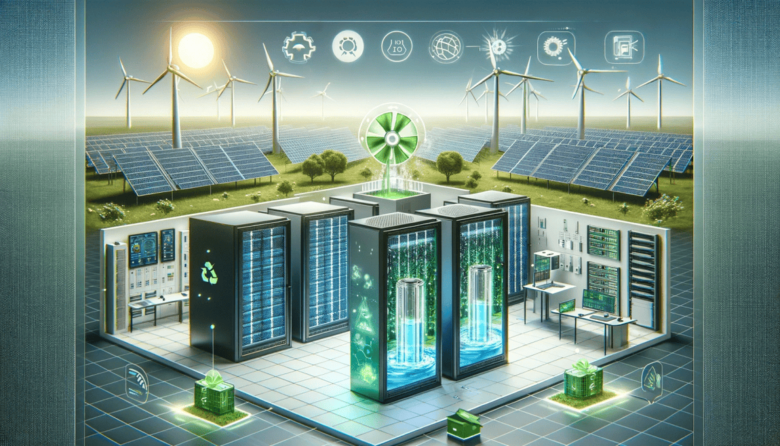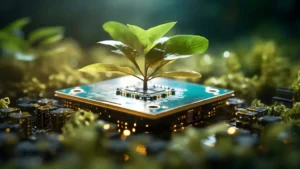In our hyper-connected digital age, data centers are like invisible engines that power everything from cloud computing to streaming services. However, this convenience also comes at a cost to the environment, as these facilities consume a lot of energy and contribute to global carbon emissions. Fortunately, the data center industry is changing with the emergence of eco-friendly solutions that make data centers more sustainable without compromising their functionality.
From AI-driven cooling systems to the integration of renewable energy, green technology is transforming data processing and storage. Companies such as Google, Microsoft, and Amazon are setting the standard, demonstrating that efficiency and sustainability can coexist harmoniously. Let’s take a look at how innovative eco-technologies can contribute to a more sustainable digital future.
The Environmental Impact of Traditional Data Centers:
Almost 1% of the world’s electricity is consumed in data centers, and this share is expected to increase as demand for digital services increases. Traditional facilities use many fossil fuels, generate a lot of heat, and require large cooling systems, all of which consume more energy. Millions of tons of electronic waste from discarded servers and hardware end up in landfills every year, exacerbating not only electricity consumption but also environmental problems. The use of water for cooling puts further strain on local resources, especially in drought-prone areas. These environmental issues highlight the data center industry’s urgent need for sustainable alternatives.
Powering Sustainable Data Centers with Renewable Energy:
Switching to renewable energy is one of the best ways to build a green data center. Tech giants are increasingly turning to hydropower, solar, and wind power to meet operational needs. For example, Microsoft is testing hydrogen fuel cells as a backup power source, and Google has been powering all of its energy needs with renewable energy since 2017. To reduce transmission losses, some companies are even building data centers near renewable energy hubs. Sustainability is a smart financial choice, as these initiatives reduce carbon footprints and stabilize energy costs in the long run.
AI-Driven Efficiency and Liquid Cooling:
Data center cooling systems can consume up to 40% of energy, which has led to advances in thermal management technology. Liquid cooling (immersing servers in non-conductive liquid) is significantly more efficient than traditional air cooling. AI optimizes energy usage by predicting server needs and adjusting cooling in real time. For example, Google’s DeepMind AI has reduced cooling costs by 40% in some facilities. These advances reduce energy waste and extend the life of electronic devices, reducing e-waste.
Edge Computing and Modular Data Centers:
Traditional data centers often consume a lot of energy and space because they are too large. Modular data centers offer a scalable alternative, allowing companies to add capacity as needed without taking up too many resources. Edge computing is another new development that makes it possible to analyze data closer to the source, eliminating the need for large, centralized facilities. Local, smaller data centers can better utilize local renewable energy and reduce energy loss during data transmission. This decentralization trend makes digital infrastructure more resilient and environmentally friendly.
Using the Circular Economy to Reduce E-Waste in Data Centers:
The rapid turnover of servers and equipment generates a lot of e-waste. Companies are using the principles of the circular economy—reusing, repairing, and recycling old equipment—to address this problem. Startups are mining rare metals from discarded hardware, while Dell and HPE have started leaseback programs for used servers. Some data centers are even designing modular components that can be modified without replacing the entire system. These projects help reduce waste and the need for new raw materials in the manufacturing process, further reducing the environmental impact of the sector.
Corporate Social Responsibility and the Role of Policy:
Corporate commitments and government legislation are accelerating the adoption of green data centers. The EU’s Climate Neutral Data Center Pact aims to achieve carbon-neutral facilities by 2030, and the United States is also encouraging the use of renewable energy through tax incentives. Amazon’s goal of net-zero carbon emissions by 2040 is one of the ambitious sustainability goals set by major digital companies. Third-party certifications, such as LEED and transparency in energy reporting, are helping companies take responsibility. With increasing public awareness, pressure from investors and consumers is pushing the sector to change more quickly and radically.
Conclusion:
Data centers have transformed into eco-friendly hubs; this is no longer science fiction. The technology sector is proving that digital expansion does not have to come at the expense of the environment through smarter infrastructure, better cooling systems, and the use of renewable energy. While there are still obstacles to overcome, we are making real progress thanks to the collective efforts of governments, companies, and entrepreneurs. As these sustainable technologies evolve, other energy-intensive businesses stand to benefit greatly. The data of the future will not only be faster and smarter but also cleaner and greener, allowing the world we live in and our digital lives to coexist in harmony.
FAQs:
1. How much energy do data centers use?
Data centers worldwide consume between 200 and 250 terawatt-hours of energy per year, which is equivalent to the energy consumption of some medium-sized countries. If we do nothing, this number could quadruple by 2030.
2. Would it be possible to run a data center entirely on renewable energy?
Many people are already doing this. Companies like Apple and Google have combined energy offsets and direct procurement to run their data centers entirely on renewable energy.
3. How difficult is it to make a data center green?
Performance and sustainability must be balanced. Because high-density computing requires a lot of electricity, improvements in efficiency and renewable energy are crucial.
4. Is liquid cooling technology safe? How does it work?
Servers are immersed in specially designed liquids that absorb heat more efficiently than air. Because the liquid is non-flammable and non-conductive, the hardware is not at risk.
5. Does a green data center cost more to operate?
In the long run, energy efficiency savings and reduced e-waste can often partially offset the initial cost of a retrofit.




